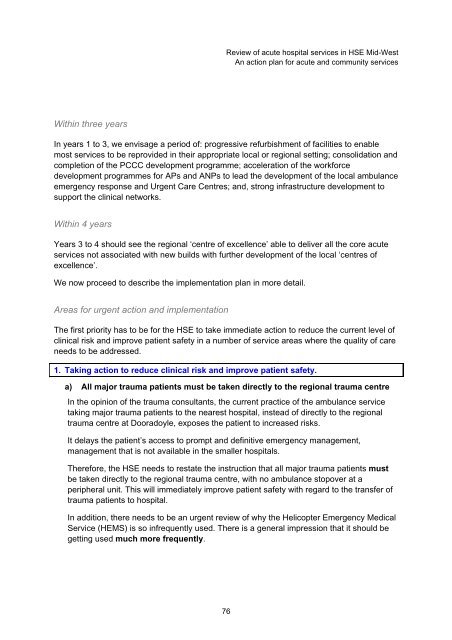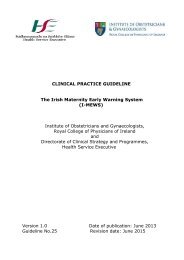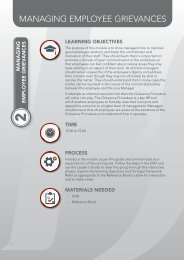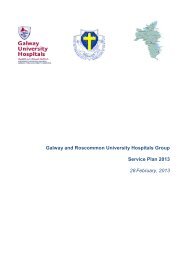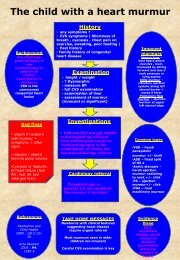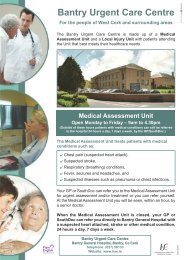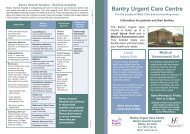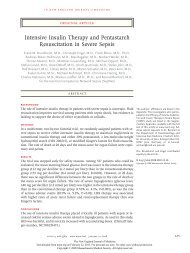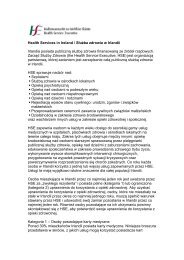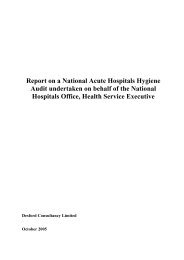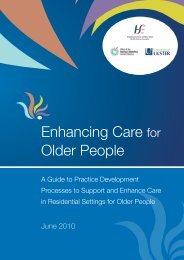Review of acute hospital services in the Mid - Health Service Executive
Review of acute hospital services in the Mid - Health Service Executive
Review of acute hospital services in the Mid - Health Service Executive
- TAGS
- acute
- www.hse.ie
Create successful ePaper yourself
Turn your PDF publications into a flip-book with our unique Google optimized e-Paper software.
With<strong>in</strong> three years<br />
<strong>Review</strong> <strong>of</strong> <strong>acute</strong> <strong>hospital</strong> <strong>services</strong> <strong>in</strong> HSE <strong>Mid</strong>-West<br />
An action plan for <strong>acute</strong> and community <strong>services</strong><br />
In years 1 to 3, we envisage a period <strong>of</strong>: progressive refurbishment <strong>of</strong> facilities to enable<br />
most <strong>services</strong> to be reprovided <strong>in</strong> <strong>the</strong>ir appropriate local or regional sett<strong>in</strong>g; consolidation and<br />
completion <strong>of</strong> <strong>the</strong> PCCC development programme; acceleration <strong>of</strong> <strong>the</strong> workforce<br />
development programmes for APs and ANPs to lead <strong>the</strong> development <strong>of</strong> <strong>the</strong> local ambulance<br />
emergency response and Urgent Care Centres; and, strong <strong>in</strong>frastructure development to<br />
support <strong>the</strong> cl<strong>in</strong>ical networks.<br />
With<strong>in</strong> 4 years<br />
Years 3 to 4 should see <strong>the</strong> regional ‘centre <strong>of</strong> excellence’ able to deliver all <strong>the</strong> core <strong>acute</strong><br />
<strong>services</strong> not associated with new builds with fur<strong>the</strong>r development <strong>of</strong> <strong>the</strong> local ‘centres <strong>of</strong><br />
excellence’.<br />
We now proceed to describe <strong>the</strong> implementation plan <strong>in</strong> more detail.<br />
Areas for urgent action and implementation<br />
The first priority has to be for <strong>the</strong> HSE to take immediate action to reduce <strong>the</strong> current level <strong>of</strong><br />
cl<strong>in</strong>ical risk and improve patient safety <strong>in</strong> a number <strong>of</strong> service areas where <strong>the</strong> quality <strong>of</strong> care<br />
needs to be addressed.<br />
1. Tak<strong>in</strong>g action to reduce cl<strong>in</strong>ical risk and improve patient safety.<br />
a) All major trauma patients must be taken directly to <strong>the</strong> regional trauma centre<br />
In <strong>the</strong> op<strong>in</strong>ion <strong>of</strong> <strong>the</strong> trauma consultants, <strong>the</strong> current practice <strong>of</strong> <strong>the</strong> ambulance service<br />
tak<strong>in</strong>g major trauma patients to <strong>the</strong> nearest <strong>hospital</strong>, <strong>in</strong>stead <strong>of</strong> directly to <strong>the</strong> regional<br />
trauma centre at Dooradoyle, exposes <strong>the</strong> patient to <strong>in</strong>creased risks.<br />
It delays <strong>the</strong> patient’s access to prompt and def<strong>in</strong>itive emergency management,<br />
management that is not available <strong>in</strong> <strong>the</strong> smaller <strong>hospital</strong>s.<br />
Therefore, <strong>the</strong> HSE needs to restate <strong>the</strong> <strong>in</strong>struction that all major trauma patients must<br />
be taken directly to <strong>the</strong> regional trauma centre, with no ambulance stopover at a<br />
peripheral unit. This will immediately improve patient safety with regard to <strong>the</strong> transfer <strong>of</strong><br />
trauma patients to <strong>hospital</strong>.<br />
In addition, <strong>the</strong>re needs to be an urgent review <strong>of</strong> why <strong>the</strong> Helicopter Emergency Medical<br />
<strong>Service</strong> (HEMS) is so <strong>in</strong>frequently used. There is a general impression that it should be<br />
gett<strong>in</strong>g used much more frequently.<br />
76


